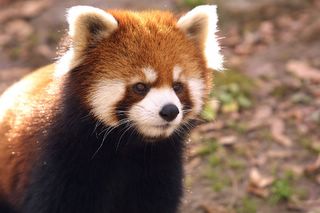
Lesser Panda (Red Panda)
Class: MAMMALIA
Order: Carnivora
Family: Ailuropodidae
Genus: Ailurus
Species: fulgens
STATUS
Vulnerable - population numbers in wild not known, but specialised diet, low production rate and low population density make this species vulnerable to extinction locally when environment changes.
COUNTRIES OF ORIGIN
Bhutan, China, India, Laos, Myanmar (Burma), and Nepal.
DESCRIPTION
The lesser or red panda is a medium-sized bear-like mammal with a thick rusty to deep chestnut coloured coat. The muzzle, eye patches and the fronts of the large pointed ears are white and there are broad white cheek patches. The tail is long and bushy with broad brown and ginger rings. The nose is black. It walks like a bear with forepaws pointed inwards. It has long white whiskers and an almost cat-like face. The forepaws have an extended pad on the sole and on the first digit to assist in climbing and grasping bamboo. The claws are sharp and partly retractable. The broad teeth and strong jaw muscles, an adaptation to chewing bamboo, have resulted in a relatively large head.
Head & body length: 510mm - 635mm
Shoulder Height: 273mm - 283mm
Tail length: 280mm - 485mm
Weight: 3.0kg - 6.2kg
HABITAT
Steep forested mountain slopes with bamboo thickets, giant rhododendron and oak, at 1800-4800 metres. The lesser panda tolerates colder temperatures than does the giant panda. It rests and shelters in trees and rock crevasses.
DIET
The diet consists mainly of bamboo, plus grasses, roots, acorns, berries and lichen. It sometimes takes insects, eggs, young birds and small rodents. Because the lesser panda has the digestive system of a carnivore it cannot digest wood fibre. It therefore has to eat large amounts of bamboo every day in order to survive.
BEHAVIOUR/SOCIAL ORGANISATION
The lesser panda is active between dusk and dawn, sleeping in trees during the day. The adults are generally solitary, but sometimes travel in pairs or small family groups. They mark their territory with scent from an anal gland, urine and faeces. Their trails are also marked automatically with scent from glands on the soles of the feet. They feed mostly on the forest floor but are excellent climbers and they are able to escape predators by climbing high into trees.
REPRODUCTION
The mating season is from January to March. During this time each female comes into breeding condition (oestrus) for about 14 days. The males fight over the right to mate with females in breeding condition. When the males meet they arch their backs and lower their heads, then stand up on their hind legs and beat each other with their paws. The gestation period is 90-150 days, with births occurring in May and June. There is a delayed implantation period, as in bears, and embryogenesis is probable about 50 days. Before giving birth the female lines a tree cavity or rock cleft with grass. Between 1 and 4 cubs are born. They are blind but fully covered with hair. Their eyes are open on the 18th day and they leave the nest for the first time at 90 days. They begin to eat solid food in autumn and are weaned before the onset of winter. They become sexually mature at 18 months. Infant mortality is very high. To produce enough milk for the cubs the mother has to eat three times the normal quantity of bamboo.
VOCALISATION
The usual communication call is a series of short whistles and squeaks. When frightened or angry they stand on their hind legs and give sharp spitting hisses (like a cat), or a series of snorts.
PREDATORS
Snow leopards are the main predators of adults, yellow-necked martens often take cubs in the nest.
LIFESPAN
Up to 14 years in captivity, but probably a lot less in the wild.
CAPTIVE LESSER PANDAS
Lesser pandas survive and breed well in captivity in many zoos around the world. They are seldom aggressive and are relatively easy to tame and handle.
REFERENCES
Schaller G.B. (1990) in Grzimek's Encyclopedia of Mammals, Vol 3.
McGraw-Hill. pp.469-471
Nowak R.M. & Paradiso J. C. (Eds.) (1983) Walker's Mammals of the World, 4th Edition pp. 977-978

No comments:
Post a Comment